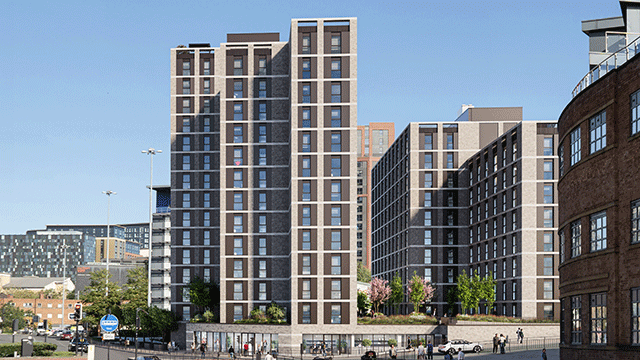The DSS PRIME transfer of the 700-property DSS estate sets a record for property PFI deals and could be the template for more. Edward Simpkins reports.
The DSS PRIME transaction, in which consortium Partnership Property Management becomes the owner of the DSS estate and provides it with serviced accommodation for 20 years, did three things.
Not only is it likely to prove to be the biggest property deal of the year but it also signals the advent of a new way of occupying property. In the short-listed bidders it has dragged three new companies into existence, with the winner becoming a huge serviced office provider and the losers busily bidding for other PFI schemes and private-sector contracts. And as a PFI scheme it is a variation on a theme, more to do with managing withdrawal from an old portfolio, gradually swapping new space for old, than just procuring a new asset.
In this, the DSS deal is in line with the PFI philosophy of government bodies concentrating on core tasks – in this case, managing benefits – and getting out of the business of managing property. The National Audit Office published its annual report last week and expressed concern over the way some PFI deals were being structured. Jeremy Colman, director of the NAO body responsible for the PFI, says: “The PFI should be about buying a service, not an asset.”
The PRIME team has been talking to the NAO during the bidding and is confident that its scheme will meet the NAO’s approval on that count as well as on the NAO’s traditional concern for value for money.
Cash payments
John Mason, director of the project at the DSS, admits that he would have preferred to transfer ownership of the DSS estate to the winning consortium without a cash payment. This would have meant a lower accommodation fee through the life of the contract, but the Treasury was insistent and PPM, a consortium led by Goldman Sachs and comprising Vines Management, Barclay Group, Richard Ellis, Symonds and Compass Management & Leasing, among others, will pay £250m. “Obviously, in an ideal world you wouldn’t have taken anything up front in terms of capital for the assets. You’d have seen the whole benefits through the running costs stream.”
The consortia are unwilling to disclose how much it cost them to bid, but one source close to the deal estimates the sum at between £2m and £3m for each consortium. The property industry has long said that bidding costs are too much compared with the risk of not being chosen, but Mason defends the process.
“When we started this, we were very conscious of the PFI’s critics. We therefore structured the procurement process to be as cost effective to both us and them as possible. It’s as expensive for the government to do as for the private sector to be involved in it.”
And he says that the structure of the bidding process was carefully conceived to get the DSS the best value for money deal while quickly weeding out the no-hope bids, so that only serious players ended up spending serious money. “If you look back to the start of the process, the initial expressions of interest, people were putting in for very little money.”
He admits that the final three bidders would have spent a “considerable” amount, but says that the decision to go from three to two instead of directly to a final bidder is justified by the savings the two consortia managed to find in a straight fight. “It was a decision that was justified by the results in terms of the improvement in quality and the removal of the conditions attached to the bids.”
He points out that if a final bidder is chosen too early, before detailed work has been done, “the price only ever goes up”.
The deal is due to be signed before Christmas with handover taking place next April. However, several issues have to be cleared up by then.
One is re-measuring the estate’s short-leasehold element. DSS adviser Chesterton is warranting the measurement of the long leasehold and freehold buildings, but information on the short leasehold estate was gleaned from files and this is one of the few factors that could alter the price.
PPM will also carry out further detailed surveys of 300 to 400 buildings before it signs on the dotted line. The consortium is not allowed to alter the overall agreed value of the estate, but it may vary the value allocated to individual buildings. “Each building has a location unit price,” Mason says, “and [the bidders] had to bid both an aggregate figure for the total charge to the department and a location-by-location price. The only way the overall price might alter is on the remeasurement.”
The other big issue is how the consortium’s service delivery is to be measured. Instead of arguing about whether a particular toilet is clean, performance will be measured in complaints. “The whole project stands or falls on this delightful performance measurement system,” Mason says. “The services they will deliver to us over 20 years are based on a series of output specifications. If they haven’t delivered the service, they don’t get paid for it.”
But the key to understanding how the deal works is the issue of risk transfer. PPM is taking on a portfolio of around 700 long and short leaseholds and freeholds ranging from neighbourhood benefits offices to the 36,481m2 (392,700 sq ft) recently built Quarry House in Leeds.
In an attempt to co-ordinate the DSS’s process of vacating the properties, the estate has been split into three groups. “The contract allows us to move out of large volumes of space,” Mason says. “The estate is defined as core, flexible and surplus and at day one we hand over to the consortia this surplus space, which we don’t want.” That surplus space amounts to around 10% of the entire estate and is PPM’s to profit from.
Manish Chande, chief executive of PPM, said that the task of classifying each property and deciding what future it might have is under way. “We’re conducting an asset-by-asset business plan which we hope will dovetail with the DSS’s own plans.”
Expertise
Surplus is likely to include Heyhouses Lane at Lytham St Anne’s, a 3.3ha (8.1 acre) site occupied by poor-quality, single-storey space and could also include part of the 19ha (47 acre) Peel Park at Lytham. Both sites are suitable for residential development and it is no coincidence that housebuilder Berkeley is a member of the consortium. Tony Pidgley of Berkeley says that he has not yet identified specific sites for his attentions, but he is confident about finding some. “Our role lies in our expertise in realising value from parts of the estate and we will be used for our residential expertise,” he says.
Mason describes the flexible category as space for which there is a current, but not a long-term, need and this accounts for around 25% of the estate. He explains that it allows for a slow withdrawal from buildings, with the flexible space further split into bandwidths of time: roughly 13% of it to be vacated in years one to five, 9% in years five to 10 and about 3% in years 10 to 15.
The remaining 65% of the estate is seen as the core of the DSS’s needs for the next 20 years, but it will have the option to move out of 185,800m2 (2m sq ft) of core space at any time. “The estate at the end of 20 years can be 45% smaller than it is now,” Mason says. At that point, PPM will have an estate with no guaranteed tenants, but the DSS has reserved an option to lease whatever it is occupying. “At the end of the time, we’ll probably have a PRIME II retendering process.”
To prevent the politically embarrassing spectacle of the consortium making enormous profits, the DSS has a claw back on development gain when it vacates space. Mason explains: “They have to share the development gain with us. Effectively, they have to provide us with incentives to go and they have to meet all our costs of rehousing.” But when the DSS moves out of a flexible building, whatever PPM does with it, there is a “deemed disposal” and if there is a development gain out of that, then the DSS gets 50% as well. “We never suffer a loss,” he says. “There are no negatives for us, only positives.”
But he stresses: “We are looking for their entrepreneurial skills. We benefit from their being smart at property, that’s why we’ve chosen them. We want them to make money out of development, we want them to make profits.”
|
Details of the deal
Ownership of the 1.7m m2 (18.2m sq ft) DSS estate, which is spread between 700 properties, is transferred to PPM for an up-front payment of £250m. PPM then has to provide serviced office accommodation for 95,000 staff for a sliding fee over a 20-year contract. The DSS may move out of 45% or less of the estate over the life of the contract and is allowed to renew leases at the end of the contract on what it still occupies. The DSS now pays £350m pa in occupation costs and hopes to achieve a reduction of between 10% and 50%. |










